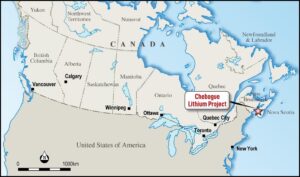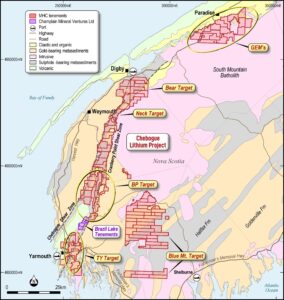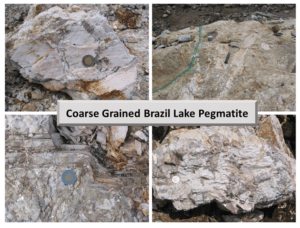Chebogue Lithium Project
Nova Scotia, Canada
The Chebogue Lithium Project covers approximately 1,200 km2 in the emerging hard-rock lithium jurisdiction of Nova Scotia, Canada. The Project represents a significant opportunity for the Company to advance a lithium project that has the potential to host spodumene-bearing pegmatites. Historic exploration in the surrounding project area has mainly focused on gold, tin, base metals, and rarely on other critical metals. A regional review was carried out by the Nova Scotia Government in 2016 and identified several areas prospective for hosting lithium-bearing pegmatites. These areas extend as far eastward as Paradise and southward to Liverpool
Project Highlights
- Large 100% owned land position comprising an area of ~1,200 km2 within 109 mineral licenses covering over 100km of prospective lithium pegmatite strike length
- MHC to become the largest tenement holder in Nova Scotia for exploration of lithium and critical metals.
- Located along strike to Champlain Mineral Ventures Ltd’s, Brazil Lake Lithium project (MRE – Indicated: 555,300T @ 1.30% Li20, Inferred 381,000T @ 1.48% Li20)and south of the former East Kemptville Tin Mine
- Heavily underexplored project area, regional review and analysis has identified several areas considered highly prospective for lithium-bearing pegmatites and backed by recent success at the neighboring Brazil Lake lithium project
- Over 100km of strike along the Silurian White Rock Formation belt of western Nova Scotia has been secured including both the Chebogue and Paradise project areas. The Paradise project area hosts coarse grained pegmatites in association with volcanic/sedimentary lithologies and the voluminous, peraluminous South Mountain Batholith
- 100% ownership of mineral licences at Blue Mountain which lies immediately adjacent, and south, of the former East Kemptville Tin Mine, that also hosts critical metals
- Excellent surrounding infrastructure including Yarmouth port, roads, power grids, and power stations, ~3 hours’ drive to the Provincial capital and port city of Halifax, and the nearby Halifax Stanfield International Airport

Figure 1: Location map of Chebogue Lithium Project
The first noted occurrence of spodumene-bearing pegmatite in the region was discovered in 1960 by the Geological Survey of Canada at Brazil Lake. The Brazil Lake Lithium Project is now privately owned by Canadian company, Champlain Mineral Ventures Ltd. Subject to completion of the Acquisition, MHC has acquired mineral licences along strike from the Brazil Lake pegmatites both to the north-east and south-west of the discovery veins. The Company has been granted the rights to explore for LCT (lithium–caesium–tantalum) pegmatites and associated critical minerals in those areas.
The recent exploration success by Champlain Mineral Ventures Ltd at its Brazil Lake Lithium Project is presented in a 2022 NI 43-101 compliant technical report and Mineral Resource Estimate for the Brazil Lake Pegmatite Deposit1. The report documents an Indicated mineral resource of 555,300 tonnes grading 1.30 % Li20 and an Inferred mineral resource of 381,000 tonnes grading 1.48% Li20.
Note: NI 43-101 Technical Report on the Mineral Resources Estimate for the Brazil Lake Project (Lithium-Bearing Pegmatite Deposit) Nova Scotia, Canada, prepared for Champlain Mineral Ventures Ltd, by Michael Cullen P.Geo., Matthew Harrington, P. Geo., and Lawrence Elgert, P.Eng, of Mercator Geological Services, dated 25 April 2022 and prepared in accordance with the requirements of National Instrument 43-101 – Standards of Disclosure for Mineral Project of the Canadian Securities Administrators reporting instrument codes. The quoted Mineral Resources Estimates are combined Pit Constrained (0.48% Li2O cut-off grade) and Underground Constrained (0.98% Li2O cut-off grade) resources.

Figure 2: Staked Mineral Licences comprising the Chebogue Lithium Project
Strategic Rationale
In addition to exploring its existing projects, MHC is focussed on commencing other exploration projects that show high potential for mineral discovery, remain largely underexplored and will allow the Company to diversify its portfolio of mineral exploration projects. This is particularly advantageous given the shift in the global metals sector towards electrification.
The only currently known lithium-bearing pegmatites in Nova Scotia are at Brazil Lake in Yarmouth County which lie within the Silurian White Rock Formation that forms a long, stratigraphic horizon from the town of Yarmouth, north-eastward to Digby and then eastward almost to Wolfville, a distance of approximately 230 kilometres. MHC will acquire a >100km stretch of this belt which includes both the Chebogue and Paradise project areas. Both zones are known to host coarse grained pegmatites, including the Brazil Lake deposit, in association with volcanic/sedimentary lithologies and the voluminous, peraluminous South Mountain Batholith.
The Company will hold the strike extension ground adjacent to the Brazil Lake pegmatites, which is one of its priority targets. The entire Silurian belt lies adjacent to the South Mountain Batholith which is the primary heat engine for the formation of pegmatites and other mineral deposits in the area.
The Paradise block hosts coarse grained pegmatites that yield large gem-quality citrine and smoky quartz with some crystals up to 1 metre in length. These crystals are very similar to those observed at Brazil Lake. No lithium or critical metal exploration has ever been completed in this area. The area of large crystals is extensive and represents a very prospective area for lithium-bearing pegmatites.The Blue Mountain Block (refer to Figure 2, Blue Mt. Target) lies adjacent to the East Kemptville Tine Mine, the largest primary tin deposit in North America. Multiple styles of mineralization in this area and lack of historical exploration for lithium and critical metals represents an opportunity for the discovery of lithium bearing pegmatites in an area where previously little attention was paid to either lithium and critical metals or pegmatites.

Figure 3: Photographic images of the Brazil Lake pegmatites (ca. 2003)
Note: Figure 3 Brazil Lake Pegmatites occur in claims adjacent to the project owned by Champlain Mineral Ventures Ltd
Initial Target Areas and Proposed Work Program
The Company’s Phase 1 exploration plans will include finalisation of data compilation and refined target generation model, rock, soil and till sampling and geochemistry, prospecting, structural analyses followed by Rotary Air Blast (RAB) / Reverse Circulation (RC) diamond drilling.
Initial discussions are underway with Queens University in Ontario under a research initiative to refine a rapid lithium (critical metals) exploration technique with assistance from the Canadian Federal Government’s Critical Minerals Strategy Fund.
Of the currently established target areas at the Chebogue Property (refer to Figure 2), first round priority will be given to the BP, TY, and GEM’s Target areas.
Local Infrastructure
The Chebogue Project is surrounded by excellent existing infrastructure including all-weather roads, ports, airport, power grids and wind plants. The Harvest highway connects all project areas with heavy haulage and wide load capability, providing easy access for mobilisation of personnel and equipment. An international airport is located in Yarmouth which is in close proximately to the Chebogue Lithium Project areas and the provincial capital of Nova Scotia, the port city of Halifax is located approximately 3 hours’ drive from the project areas.
Throughout the project area there are numerous high voltage transmission lines cutting across the area. During the era of the East Kemptville Tin Mine, a major transmission line was built to the mine site which is located 14 kilometres from MHC’s Chebogue Property.
There are three available shipping ports in close proximately to the project including; The Shelbourne port, Digby port and Yarmouth port. The Yarmouth port is the first secure port of destination from the US Eastern Seaboard and one of the four ports of entry to Nova Scotia for international vessels.